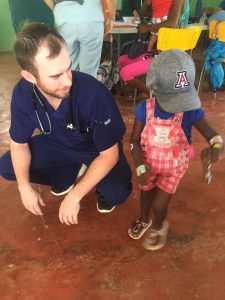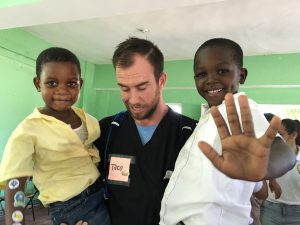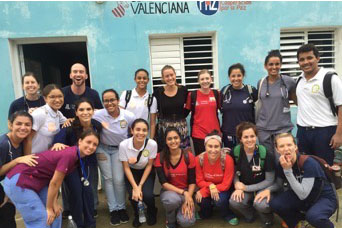Friday, September 30, 2016
A small village about 50 miles outside of Santa Domingo
It was our last day on the trip. We had flown into Santa Domingo on Sunday, piled into a bus 24-people strong (I know because we did an audible roll-call by numbers each time we piled into a vehicle), headed to Jumbo to load up on snacks for the weekend, and eventually settled into our suite at Nuestros Pequeños Hermanos (I’ll call it NPH from here on out).
Monday and Tuesday, we had worked in a village just north of NPH. On those days, we saw a lot of school children which meant two things: our normal physical exam was going to be perfected, and we were going to run out of stickers fast. I quickly became friends with Miguel and Eduardo during these days, and the friendship with “my brothers” lasted well into the trip.
Wednesday was our “off day”—as if this whole trip was not a beautiful rest in itself. We spent time at the beach, enjoying the warm water and unique weather. The sun visited frequently that day, but in whatever pattern it so desired with no consistency. The rain seemed to do the same thing, but it wouldn’t ruin our parade. The whole night was filled with dancing; Nicolas led us well.
Thursday and Friday, it was back to work (still shocked that we referred to this as work). Thursday was an awesome day. We started the day by dancing—I think I made up a line dance that morning and taught it to the crew. (Pictures or it didn’t happen, right?) I got to work in the morning with my dear friend Madalyn. I think we spent the whole morning helping a family of three—either we were super slow, or they had a lot they wanted to talk about. Probably both. I will remember that day for a long time. Using our limited knowledge, we threw ideas back and forth of what could be causing this woman’s headaches. We discussed diet changes, triggers, and life stressors, and we performed a complete neuro exam in order to r/o (“rule out”) any brain tumors. After a day in the clinics, it was back to NPH for basketball and soccer. Somehow the kids got the biggest kick when we played “USA vs Dominican Republic”—I have not been surrounded by such a grateful people ever in my life.
Friday was a special day, even more special than the rest of the trip, because I flew solo through a complete diagnosis and treatment plan for the very first time. You only do that once, right?
We set up in a small two-story building.
I saw about 12 patients during the morning shift, but I vividly remember one. He told me his name. He was a younger guy, in his mid-thirties, and recently single. He kept saying his whole body hurt, and then he said he felt numb. It only took a few questions to r/o multiple sclerosis; yes, that was my first thought and I am only slightly embarrassed to admit it. Disseminated gonococcal infection was a diagnosis that entered my mind but quickly left. After a full interview and physical (I was on my own and speaking Spanish, so it took a while), I was on to something. “Wait, you recently started drinking a lot of protein shakes? Have you started a new workout program?” I asked. He told me that for the past two weeks, he has been working out for 3-4 hours per day with only one day off. “I got this,” I thought confidently to myself.
“Have you noticed dark urine?” I asked. “Yes! I have!” he exclaimed. His eyes lit up, and for the first time, I knew he trusted me.
“Ven conmigo,” I commanded. We ran downstairs, and I asked the pharmacy for a urine cup. I was going to do a dipstick urine study. This is where things get good.
I was new to this clinic building and did not know where the bathroom was. I tried one door, but it was locked. (I later discovered the door led to the storage room.) I continued to look around the first floor of this small house. My patient pointed and said “I can go there.” He was pointing to a small den under the stairs that was hidden away from the other people in the building. Being the flexible and somewhat spontaneous person I am, and thinking this was a great idea, I said, “Sure!” As he ducked below the stairs, I stood guard. Dr. Barcellona saw me and asked what was going on. I only had time for “We couldn’t find the bathroom so . . . ” before she exclaimed, “Oh God, nooo!” Cue the patient returning from under the stairs, claiming, “I am done anyways.” Dr. B couldn’t help but laugh; at this point, all she could say was “Tanner,” smiling and shaking her head in confused disappointment. I like to think she was bewildered by my creativity and innovation. I am convinced she was slightly impressed by my ability to think on my feet, but maybe this is coping mechanism to process the fact that she may hate me forever.
 Well, I ran the dipstick on the urine and found myself right where I wanted to be. The dipstick came back positive for “blood.” Because the dipstick measures heme, it will come back positive for “blood” any time there is hemoglobin or myoglobin in the sample. It can also come back positive for ischemic heart disease or acute coronary syndrome, but my patient denied chest pain, fatigue, lightheadedness, or dyspnea. There was not hemoglobin in my patient’s urine; there was myoglobin. “It’s rhabdo,” I told myself.
Well, I ran the dipstick on the urine and found myself right where I wanted to be. The dipstick came back positive for “blood.” Because the dipstick measures heme, it will come back positive for “blood” any time there is hemoglobin or myoglobin in the sample. It can also come back positive for ischemic heart disease or acute coronary syndrome, but my patient denied chest pain, fatigue, lightheadedness, or dyspnea. There was not hemoglobin in my patient’s urine; there was myoglobin. “It’s rhabdo,” I told myself.
My patient had a condition called rhabdomyolysis (“rhabdo” meaning “striped,” “myo” meaning “muscle,” and “lysis” meaning “break down”). His recent onset of intense workouts with minimal rest time has caused his striated skeletal muscle to break down rapidly. He was producing more myoglobin that his body could process; it was overflowing through the kidneys into his urine. That is why his urine was various shades of dark brown over the past week. This is all an easy fix with some proper education.
I got to educate my patient on what was causing his pain and how to prevent it. I taught him about proper nutrition and healthy exercise habits, created a schedule for him to safely exercise, and gave him ibuprofen for his pain and soreness; his kidney function was fine.
I ran back upstairs and told my story to Noah (Dr. Grams) and Bud (Dr. L) who both affirmed my actions with a “Good job. You nailed it.” They asked about a differential diagnosis, which I was able to provide and defend. They told me my workup was thorough and complete, the urine dipstick was the right test, and my treatment plan was correct. I told my patient he could leave.
The high I felt from this encounter lasted for a while; in fact, a part of it remains. That was my first solo flight, and I did not crash and burn. This may seem like a simple case, sure—rhabdomyolysis can almost be diagnosed by a thorough history alone. Maybe that is what made it the perfect starting point for me. Yet, I am grateful for this experience. The feeling of helping someone in their confusion and pain is extremely satisfying. I am grateful for the opportunity to do this for the rest of my life.
People always told me “it will all be worth it.” I believe them now.
Tanner Heckle is a third-year medical student who grew up playing and coaching sports in Sacramento, California. Throughout his undergraduate time at Pepperdine University, Tanner's athleticism transferred from the field to the stage as he discovered his love for dancing and theater. He now enjoys exploring all forms of art, including writing, as a way to express honesty and feel emotion. His self-deprecating and stream-of-conscious style is likely a reflection of his eight siblings.

